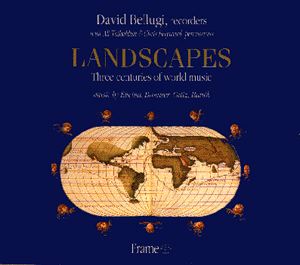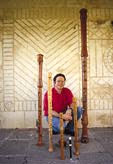
|
David Bellugirecorderswith Ali Tajbakhsh & Chris HaywardpercussionLANDSCAPESThree centuries of world musicCD FR9506-2 | |||||||||||||||||||||||||||||||||||||||||||||||||||||||||||||||||||||||||||||||||||

David Bellugi
recorders
with Ali Tajbakhsh & Chris Hayward
percussion
LANDSCAPES
Three centuries of world music
CD FR9506-2
![]()
PRESENTATION (Italiano/English)
BIOGRAPHIES (Italiano/English)
TITLES
CREDITS
![]()
This record is a collection of ethnic-inspired music from different cultures of the 15th, 16th and 20th centuries. The latest in modern digital technology gave me the opportunity to create a "virtual" orchestra in which I not only play all of the instruments, except the percussion, but am also arranger and conductor. The instruments I play are all recorders, plus a quartet of crumhorns in the Ortiz Recercada ; their number varies from 6 (Bartok) to 18 (in some of the Renaissance dances).
The recorder has a close relationship to certain folk and ethnic instruments whose music stems from an oral tradition: indeed, much of Early Music either re-elaborates aspects of popular culture or becomes synonymous with it. Encina, for example, freely borrows from popular Castilian culture, while Gervaise's branles are examples of notated folk music. In these musical contexts percussion parts, always improvised, play a dual role: decorative and structurally determinant.
The pieces in this recording can be divided into two groups each requiring different solutions: ensemble pieces with all parts of equal importance and solo pieces with accompaniment. The first group includes Brouwer's Paisaje, Bartok's Roumanian dances and most of the Hungarian tunes, whereas the branles, the Ortiz, and the Klezmer dances belong to the second one.
In Brouwer's Paesaje cubano each instrument is "choreographed" to "dance" through the stereo spectrum with a different period of time. To really appreciate this choreographic effect try listening with headphones and "visually" following each voice with your ears.
In Bartok's dances, I first recorded a synthesis of all the parts on one instrument in order to construct a coherent and stimulating interpretive mold. I then overdubbed the standard SATB formation of recorders and added two 6-foot basses to support the bass line (like double basses of an orchestra). The mold, having served its purpose, was then discarded.
As for Gervaise's branles, Ortiz's Recercada and the Klezmer dances, I recorded the accompaniment in a sound-proofed studio and then added the solo part in the natural acoustics of a small church: the orchestration of the accompaniment uses choirs of instruments, like the "registration" on an organ, where one note may be played by several different instruments in different octaves. Klezmer music, aptly defined by the great Giora Feidman as "Jewish Soul Music," owes its particular oriental flavor to the use of various modes which employ the distinctive interval of the augmented 2nd (for example: D-Eb-F#-G-A-Bb-C#-D).David Bellugi
Questo disco presenta una raccolta di musiche provenienti da epoche e cultura diverse, ma che hanno in comune una marcata connotazione etnica.
Il filo conduttore è costituito dal flauto dolce, strettamente imparentato con altri strumenti di ascendenza popolare, le cui radici musicali affondano nella tradizione orale.
Moltissima musica colta (in particolare quella che oggi chiamiamo "musica antica") rielabora aspetti della cultura popolare, talvolta confondendosi in essa: se Encina usa liberamente temi e motivi della tradizione castigliana, i branles di Gervaise sono veri e propri modelli di trascrizione diretta dal patrimonio popolare. In questo contesto le percussioni assumono un ruolo assai delicato, di funzione decorazione da una parte, ma anche nel sottolineare le strutture formali dall'altra.
L'applicazione della più recente tecnologia digitale mi ha offerto la possibilità di creare un'orchestra virtuale il cui repertorio ho curato, elaborato e diretto, suonando personalmente, eccetto le percussioni, tutti gli strumenti della famiglia del flauto dolce e del cromorno.
Le composizioni che ho scelto sono raggruppabili in due distinte categorie: pezzi d'insieme con parti di uguale importanza (Paesaje cubano, danze rumene di Bartok e quasi tutti i temi ungheresi) e pezzi solistici con accompagnamento (Branles, Recercada, danze Klezmer). Ovviamente ciascun gruppo ha richiesta soluzioni tecniche diverse. Nel Paisaje di Brouwer ogni strumento segue una sorta di coreografia, muovendosi da un lato all'altro dello spettro stereofonico secondo periodi diversi (per godere al massimo di questo effetto è consigliabile un ascolto in cuffia, seguendo gli s postamenti di ciascuna voce). Per le danze di Bartok ho cominciato registrando, con un solo strumento, una sistesi di tutte le parti per costruire uno "stampo" interpretativo coerente e stimolante: su questo ho sovrainciso la conocica formazione soprano, contralto, tenore e basso più due flauti subbassi a rinforzo. A questo punto lo "stampo", esaurito il suo compito, è stato archiviato.
Per quanto riguarda il secondo gruppo di composizioni, ho registrato in studio le parti di accompagnamento, aggiungendo la parte solistica sfruttando l'acustica naturale di una piccola chiesa. Nell'orchestrazione dell'accompagnamento, ho usato diversi gruppi strumentali ("cori"), seguendo la filosofia dei registri organistici, dove ciascuna nota può essere radoppiata in diverse ottave da varii strumenti.
La musica Klezmer -- acutamente definita "Jewish Soul music" dal grande Giora Feidman -- deve il suo profumo orientaleggiante all'uso di scale che presentano con insistenza l'intervallo di seconda aumentata (ad esempio: re-mib - fa# - sol - la - sib - do# - re).
David Bellugi

David Bellugi, born in USA, has a degree in applied musicology from the University of California at San Diego. He studied early music interpretation with Antoine Geoffroy-Dechaume in Paris. He is a regular performer as soloist with orchestras, early music ensembles and in recitals in Europe and North America. David lives in Florence, Italy where he teaches recorder at the "Luigi Cherubini" Conservatory.
Bellugi's other recordings for FRAME include the Luciani and Vivaldi concertos on FR01C93 and the "Cardellino" on FR9405-2.
Ali Tajbakhsh, born in Teheran, studied zarb with Nasser Farhaingfar. A remarkably versatile musician, Ali, who lives in Tuscany, is equally at home in any musical language: traditional, ethnic, jazz and early music.
Chris Hayward, a flutist, composer, pedagogue and producer, as well as percussionist, has an active career in classical, jazz and improvised music. Chris, who lives in the Paris region and is constantly in demand for his many refined talents, has participated in well over 100 recordings.

David Bellugi, nato negli USA, si è diplomato in musicologia applicata all'Università della California a San Diego. He studiato interpretazione della musica antica con Antoine Geoffroy-Dechaume a Parigi. Suona regolarmente come solista con orchestre ed in recitals in Europa e Nord America. David abita a Firenze dove insegna flauto dolce al conservatorio "Luigi Cherubini".
Altri dischi di David Bellugi su FRAME: FR01C93 (concerti di A. Luciani e Vivaldi), FR9405-2 ("Cardellino" di Vivaldi).
Ali Tajbakhsh, nato a Teheran, ha studiato zarb con Nasser Farhaingfar. Musicista straordinariamente eclettico, Ali, che vive in Toscana, è musicalmente a suo agio in qualsiasi linguaggio musicale: tradizionale, etnico, jazz o musica antica.
Chris Hayward, flautista, compositore, didatta e produttore, oltre che percussionista, ha un attivissima carriera in musica classica, jazz e musica improvvisata. Chris vive nella regione Parigina ed è molto richiesto per i suoi molteplici e raffinati talenti. Ha partecipato in ben oltre 100 registrazioni discografiche.
Ali Tajbakhsh : zarb, daf & djembé - Chris Hayward : palmas & finger cymbals
Juan del Encina (1468-1529):
Villancicos & Romances
1. Amor con fortuna
2. Triste España
3. Ay, triste que vengo
4. Pues que ya
Béla Bartók (1881-1945):
5. Roumanian Folk Dances
(Bot-tánc, Brâul, Topogó, Bucsumi tánc,
Román Polka, Aprózó)
Renaissance Hungarian Tunes:
6. Wir Glauben all an einem Gott (István Gálszécsi, 1536)
7. Histoire vom Propheten Elias (anonymous,1542)
8. Magyar Tánz (anonymous, 1562)
9. Untitled (anonymous,1600)
10. Ungarescha (after J. Paix, 1583)
11. Passamezzo ongaro (anonymous, 1573)
12. King David (Tinódi Sebestyén, 1549)
13. Melody of the Danube (Tinódi/Kodaly)
Leo Brouwer (1939)
14. Paesaje cubano con rumba (1985)
Klezmer dances
15. Roumanian Horra and Bulgar (traditional)
16. Frailach (A. Olshanetsky)
17. Gypsy Bulgar (traditional)
Claude Gervaise (16th century)
(Livres de Danceries, 1555)
18. Bransle Gay II
19. Bransle de Champaigne X
20. Bransle Gay VII
Diego Oritz (c.1510-c.1570)
(Trattado de las glosas ... 1555)
21. Recercada Primera
Producer: Paolo Paolini
Sound Engineer: Marzio Benelli
Digital Editing: David Bellugi
Design: Enrico Pacini
Photos: Ramona Brané
Recording location: S.Angiolo Vico l'Abate Greve in Chianti, Italy
Technical notes: TAPRC (Total Acoustic-Phase Recording Concept)
microphones: Neumann, AKG, Schoeps
digital tape recorders: TascamDavid Bellugi plays on instruments built by Thomas M. Prescott.
The cover, from Battista Agnese's Atlante nautico (1543), depicts Magellan's route to the Orient. (Ms. Med. Palat. 245, cc 12v13r). Permission kindly granted by Biblioteca Medicea Laurenziana of Florence.
We wish to thank the Castelli del Grevepesa (producers of Chianti Classico wine) for their warm hospitality at Sant' Angiolo Vico l'Abate.